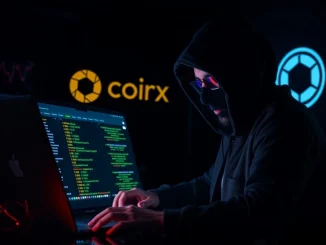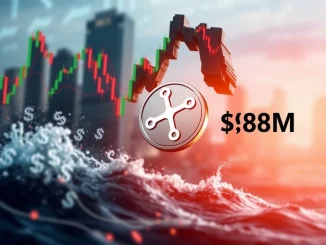
In the fast-paced world of digital assets, keeping track of significant movements can offer valuable insights. Recently, the popular blockchain tracking service Whale Alert reported a substantial transaction involving XRP, the cryptocurrency associated with Ripple. According to their alert, a staggering 470 million XRP was locked into escrow by Ripple itself. This kind of movement is not uncommon for Ripple, but the sheer volume always grabs attention within the crypto news sphere. What does this mean, and why does Ripple engage in these large-scale escrow operations?
Whale Alert Reports Massive XRP Escrow Lock
The initial report came directly from Whale Alert, a widely recognized platform that monitors and reports large transactions on various blockchains. Their automated systems detected the transfer of 470 million XRP into an escrow account controlled by Ripple. For those new to the space, Whale Alert acts like a digital detective, highlighting movements that could potentially signal significant activity by large holders, often referred to as ‘whales’. In this case, the ‘whale’ is Ripple itself, executing a planned part of its token management strategy.
Here’s a quick breakdown of the reported transaction:
- Asset: XRP
- Amount: 470,000,000 XRP
- Action: Locked into Escrow
- Initiator: Ripple
- Reporter: Whale Alert
This specific transaction is part of a larger, ongoing process that Ripple established years ago to manage the supply of XRP.
Understanding Ripple’s XRP Escrow System
Back in 2017, Ripple committed to placing 55 billion XRP (which was roughly 55% of the total supply at the time) into a cryptographically secured escrow system. The purpose was to create certainty around the maximum circulating supply of XRP at any given time. The escrow works on a schedule: 1 billion XRP is released from escrow on the first day of each month. Ripple can then use these released funds for various purposes, such as:
- Funding its operations
- Selling to institutions
- Incentivizing partnerships
- Investing in the XRP ecosystem
Any amount of the released 1 billion XRP that is not used or sold by the end of the month is typically placed back into a new escrow account, set to expire 55 months later. This cycle continues month after month. The 470 million XRP locked in escrow reported by Whale Alert is likely a portion of the 1 billion XRP released at the start of the month that wasn’t utilized by Ripple and has now been returned to escrow.
Why Does Ripple Lock XRP?
The primary reasons behind Ripple‘s extensive use of the XRP escrow system are rooted in supply management and transparency. Before the escrow was established, concerns existed about the large amount of XRP held by Ripple and the potential for sudden, large sales that could impact the market price. By locking up the majority of its holdings, Ripple aimed to provide the market with predictability regarding future supply.
Key reasons include:
- Supply Predictability: The monthly release schedule makes the maximum potential increase in circulating supply known in advance.
- Market Confidence: It signals that Ripple is not planning to dump its entire holdings onto the market simultaneously.
- Long-Term Strategy: It aligns with Ripple’s long-term vision for XRP adoption, ensuring funds are available over many years for ecosystem development and partnerships.
- Transparency: The on-chain movements are trackable by services like Whale Alert, adding a layer of transparency to Ripple’s management of its XRP holdings.
The escrow mechanism is a fundamental part of the XRP ecosystem and is often discussed in crypto news updates related to Ripple.
Implications for XRP and the Market
When Whale Alert reports a large amount of XRP being returned to escrow, as with this 470 million transaction, it generally means that Ripple did not use the full 1 billion XRP released at the start of the month. This can be interpreted in several ways:
- Lower Circulating Supply Increase: Less XRP than the maximum possible entered the circulating supply this month. This is often viewed positively by market participants as it reduces potential selling pressure.
- Ripple’s Financial Position: It might suggest Ripple had sufficient operational funds or didn’t execute large-scale institutional sales or partnership incentives requiring the full amount this period.
- Routine Operation: Fundamentally, it’s the escrow system working as designed. The unused portion goes back into a new lock-up.
While a single escrow lock-up transaction doesn’t typically cause drastic price swings for XRP, it’s a data point analysts and investors consider when evaluating the token’s supply dynamics and Ripple‘s activities. It’s a recurring event that is part of the predictable flow of XRP supply management.
Keeping Up with Crypto News
For anyone interested in the digital asset market, following crypto news sources and tracking services like Whale Alert is essential. They provide real-time data on significant on-chain movements, offering glimpses into the activities of major players like Ripple. Understanding events like large XRP escrow transactions helps build a more complete picture of the market’s mechanics and the strategies employed by companies and individuals holding substantial amounts of cryptocurrency.
While the 470 million XRP lock-up is a routine function of Ripple’s escrow system, its reporting by Whale Alert serves as a reminder of the transparent and predictable supply management strategy that Ripple implemented for XRP years ago. It highlights the ongoing nature of this system and its role in the broader XRP ecosystem.
Staying informed through reliable crypto news outlets ensures you are aware of these key developments and can understand their context within the larger market narrative.
Conclusion
The report from Whale Alert about 470 million XRP being locked back into escrow by Ripple is a standard operational event within Ripple’s long-established supply management system. This system, initiated in 2017, locks up billions of XRP and releases a predictable 1 billion XRP each month, with unused portions being re-escrowed. This mechanism provides transparency and predictability regarding XRP‘s circulating supply, aiming to build market confidence and support the long-term growth of the XRP ecosystem. While not necessarily a market-moving event on its own, such reports are valuable pieces of crypto news that help observers understand the ongoing dynamics of one of the market’s significant digital assets and its issuing entity.



